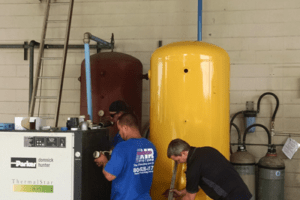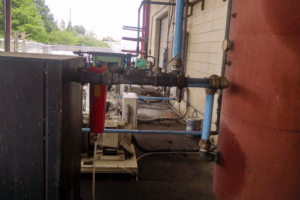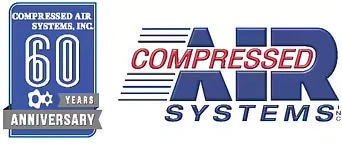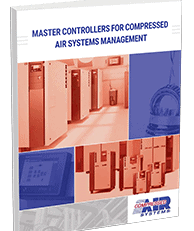Eliminating Oil Leakage for Norris Precision Manufacturing
The Problem
 In early 2020, Norris Precision Manufacturing—a manufacturer specializing in precision parts for the aerospace, medical, and military industries—began experiencing oil leakage issues. Oil entered the pipeline of the facility’s compressed air system and dripped out of the pipe threads into equipment. The intrusion of oil forced the company to invest in replacement tools for the affected equipment. Given Compressed Air Systems (CAS) extensive experience selling, renting, and servicing air compressors and other pneumatic systems, the company knew they could trust in the CAS team to provide a solution that eliminated the problem and improved the system’s overall effectiveness and efficiency.
In early 2020, Norris Precision Manufacturing—a manufacturer specializing in precision parts for the aerospace, medical, and military industries—began experiencing oil leakage issues. Oil entered the pipeline of the facility’s compressed air system and dripped out of the pipe threads into equipment. The intrusion of oil forced the company to invest in replacement tools for the affected equipment. Given Compressed Air Systems (CAS) extensive experience selling, renting, and servicing air compressors and other pneumatic systems, the company knew they could trust in the CAS team to provide a solution that eliminated the problem and improved the system’s overall effectiveness and efficiency.
The system in question consisted of two 50 HP compressor units with a 125 PSIG pressure rating and 200 ACFM volume ea. rating connected directly to a 500 cfm Cycling refrigerated air dryer. After inspecting the system, the CAS team found the following issues:
- The discharge of the refrigerated air dryer unit lacked an oil removing filter.
- Both controller units ran in constant mode. Additionally, they had pressure controls set for 120–130 PSIG with a target pressure of 125 PSIG and modulation control units that required adjustment.
- Both units were piped directly into the Air Dryer, providing a 4-6 psi restriction and only had a minimal dry storage, reducing the available storage capacity for energy efficiency.
- The first unit surpassed the recommended cycling limit, while the second unit remained at around 40% capacity, which increased oil passage
- The two units also had an output differential for 4 PSIG between them.
These factors led to the oil leakage as well as contributed to lower efficiency, higher energy consumption, and greater wear in the system.
The Solution
After evaluating the compressed air system in Norris Precision Manufacturing’s facility, the CAS team determined to turn the dry receiver into a wet receiver. A Wet receiver provide additional storage capacity and reduce moisture. The large surface area of the air receiver acts as a free cooler, which is what removes the moisture. Because the moisture is being reduced at this point in the system, the load on filters and dryers will be reduced. The term “wet receiver” refers to the storage vessel or tank placed immediately after the compressor. This device helps with contaminant removal, pressure stabilization and pulsation reduction.
The discharge of a Refrigerated Air dryer is where any oil will coalesce and therefore, the integration of an oil removal filter element and a new 400-gallon Dry air receiver were implemented. This along with the servicing and adjustment of the existing compressor units would fully resolve the company’s system problems. The oil filter—rated for 500 CFM—would be installed on the discharge of the refrigerated air dryer to provide oil liquid separation up to 0.01 mg/m³. The new air receiver would be used as a dry receiver, while the existing one would be used as a wet receiver with an automatic magnetic drain (AMD) 6550 design. Once fully serviced and adjusted—operations that included changing the modulation controls on both units and altering the controls (to automatic) and pressure target (to 105 PSIG) of the second unit—the existing compressor units would work more efficiently and effectively.
The Result
 Once Norris Precision Manufacturing approved the recommendations, the CAS team worked swiftly to install and/or service the necessary components. After the work was completed, in addition to no longer having to deal with oil leaking into and out of the system, the company found they experienced the following benefits:
Once Norris Precision Manufacturing approved the recommendations, the CAS team worked swiftly to install and/or service the necessary components. After the work was completed, in addition to no longer having to deal with oil leaking into and out of the system, the company found they experienced the following benefits:
- The installation of the new filter element removed some of the oil, moisture, and solid particles in the air resulting from the pass through the compressor or aftercooler,
- The installation of the new wet receiver reduced the compressor cycling in the first unit, decreasing the amount of wear experienced by the compression module, capacity control system, and motor which helped maintain dew point and reduce energy consumption in the cycling dryer.
- The modifications to the compressors’ control units offset the transducer differential.
- The totality of changes allowed for the integration of additional storage capacity to compensate for surges in compressed air demand and the reduction of energy usage during the compressor motor startup stage.
Norris Precision Manufacturing was fully satisfied with the new system. While the total cost of the project was $11,235, the estimated annual savings in electricity enabled by the upgrades was more than $30,000. Additionally, at the start of the project, the expected return on investment (ROI) was calculated to be about 13 months, but it has since been reduced to eight or nine months.








